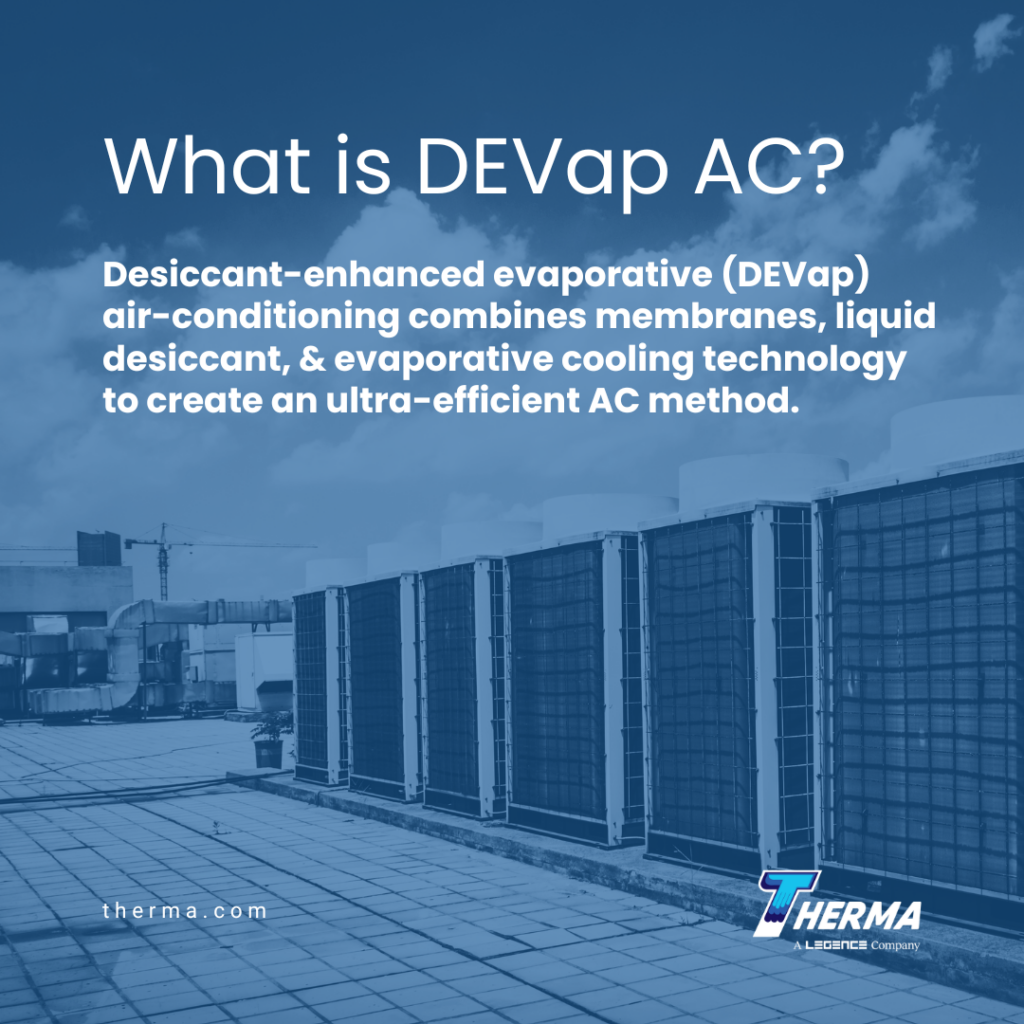by Ali Kriscenski
Desiccant-enhanced evaporative (DEVap) air-conditioning combines membranes, liquid desiccant (drying material), and evaporative cooling technology to create an ultra-efficient AC method. Since its development by the National Renewable Energy Laboratory, DEVap AC has been touted as a significant innovation in energy efficiency. In this article, we’ll look at how this technology could benefit your operational strategies and goals.
How DEVap Works
DEVap AC uses two stages to condition incoming air: a dehumidifier stage and an indirect evaporative cooling stage. Fresh makeup air combines with building return air to create the supply stream through the two stages.
In stage one, supply air passes through a membrane with the desiccant causing water to evaporate while cooling the drying material. In stage two, the supply air passes over a water-impermeable surface that creates evaporative cooling. A small portion of the cooled, dry supply air passes through the evaporative stage again removing moisture before being exhausted.

Benefits of DEVap
The U.S. Department of Energy reports that DEVap uses up to “90 percent less electricity and up to 80 percent less total energy than traditional air conditioning,” with an estimated payback in three years. Unlike traditional air conditioning technology, DEVap utilizes water as a refrigerant rather than hydrochlorofluorocarbons (HCFCs) or hydrofluorocarbons (HFCs) which both have negative impacts on the environment.
Another benefit of using water as a refrigerant is the elimination of compressors to manage and contain the refrigerant. This reduces the complexity of the equipment, and the space requirements, and also alleviates maintenance and service processes associated with chemical refrigerants.
Traditional air conditioning uses considerable energy to dehumidify hot air. The condenser process in traditional AC is particularly energy-intensive in humid climates or seasons. DEVap AC utilizes moisture in the air to create evaporation which enhances the cooling process and effects. This distinction is where DEVap AC creates promising energy efficiency.
DEVap AC has the potential to create higher thermal comfort satisfaction for occupants. In the DEVap process, temperature and humidity are handled separately. This uncoupling allows for better control of environmental conditions resulting in higher quality conditioned air that feels more comfortable.
Cost Savings with DEVap
The efficiency of DEVap AC brings the benefit of reduced energy consumption and cost savings, with some predictions as high as 90%. The energy performance of DEVap depends on the climate, with higher energy savings could be expected in dryer climates. NREL’s early modeling simulations showed a variance between climates, however with energy savings achieved consistently.
Additionally, DEVap reduces peak power demand creating less strain on utilities with the potential to reduce brown and blackouts. These two factors equal lower overall energy consumption and reduced operational disruptions.
Considerations for DEVap AC
DEVap has been gaining attention as an innovative advancement away from traditional air conditioning. As companies prioritize energy efficiency, decarbonization, and greener building technologies, DEVap offers considerable benefits toward these larger strategic goals.
Currently used in commercial applications, the DEVap units can incur a higher upfront cost than traditional air conditioning units. However, the energy savings can create a rapid payback timeline of a few years making the investment a solid long-term strategic decision.
While DEVap is a relatively young technology, it is in many ways a simpler approach to air conditioning. With no compressor, or copper coils, and fewer moving parts such as pumps and fans. This gives the technology an advantage as it gains market traction.
Industry professionals recognize how DEVap AC can help businesses reach their energy and sustainability goals. The technology delivers a level of efficiency that brings a multitude of benefits to clients.
The professionals at Therma can help you navigate the selection and design of DEVap AC for your building or facility. Contact Therma today.
AUTHOR BIO
Ali Kriscenski was trained in high-performance building design at Boston Architectural College. She has worked with leading architecture and construction firms in NYC and New England and served on the executive team at the Forest Stewardship Council International. She was the managing editor at Inhabitat and has worked pro bono for the Green Building Institute, ISEAL Alliance and Habitat for Humanity.
Sources
NREL – NREL DEVap Fact Sheet
ACHR News – NREL’s Energy-Saving DEVAP Air Conditioner Cuts Peak Power Loads







